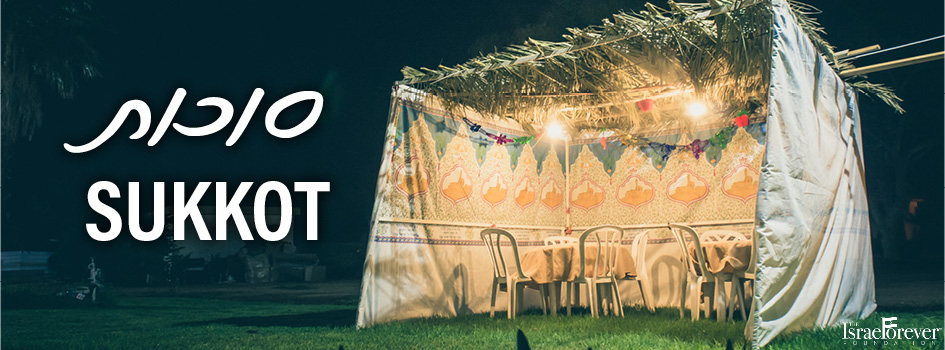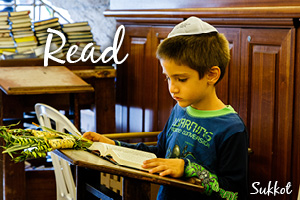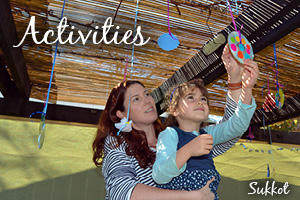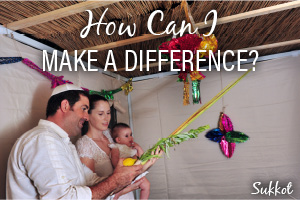Sukkot

Sukkot is a holiday, rich in symbolism and rituals designed to convey deep messages in a simple way.
On Sukkot we commemorate the journey of the children of Israel towards the promised land, following God through the desert, to the unknown, dependent entirely on God for survival:
“You shall dwell in Sukkot for seven days… so that your future generations shall know that I had the children of Israel live in Sukkot when I brought them out of Egypt….” (Leviticus 23:42-43).
Sukkot is also a harvest holiday, marking the end of the harvest time and thus of the agricultural year in Israel. The Hebrew word “sukkah” (plural=sukkot) is a walled structure covered with s'chach (plant material such as overgrowth or palm leaves). This is the type of temporary dwelling in which the farmers of ancient Israel would live during harvesting and that which the children of Israel used during their forty years in the desert, following the Exodus. The symbol of the sukkah ties together these two aspects of the holiday, showing the connection between them –
In exile, Jewish existence is transient. That was true following the Exodus and became true again, after the Nation of Israel was exiled from the land.
It is the Land of Israel, like a living entity, that gives a previously non-existent completion to the Jewish People, allowing us to put down roots and harvest the fruits of our labors.
WHY ARE WE COMMANDED TO LIVE IN SUKKOT?
Sukkot reminds us of our humble beginnings as a nation and of the impermanence of our existence without God’s protection.
“How odd of God / to choose the Jews,” goes the famous rhyme, to which the answer is: “Not quite so odd: the Jews chose God.” They may have been, at times, fractious, rebellious, ungrateful and wayward. But they had the courage to travel, to move, to leave security behind, and follow God’s call, as did Abraham and Sarah at the dawn of our history. If the sukkah represents God’s clouds of glory, where was “the loving-kindness of your youth”?
There is no sacrifice involved if God is visibly protecting you in every way and at all times. But if we follow Rabbi Akiva and see the sukkah as what it is, the temporary home of a temporarily homeless people, then it makes sense to say that Israel showed the courage of a bride willing to follow her husband on a risk-laden journey to a place she has never seen before – a love that shows itself in the fact that she is willing to live in a hut trusting her husband’s promise that one day they will have a permanent home.
During the holiday it is customary to sleep, eat meals and host friends in the sukkah. On each day of the holiday it is mandatory to perform a waving ceremony with the Four Species, the Lulav and the Etrog.
LULAV AND ETROG
Lulav is a closed frond of the date palm tree. It is one of the Four Species used during Sukkot. The other Species are the hadass (myrtle), aravah (willow), and etrog (citron). When bound together, the lulav, hadass, and aravah are commonly referred to as "the lulav".
There are various explanations detailing why we are commanded to combine the species and use them in a very specific manner while reciting a blessing every day of the holiday. All the interpretations have to do with unity, balance and parts completing a whole.
One popular rabbinic teaching is that the four species, symbolize the human condition and one’s relationship with God. The etrog is shaped like the heart, and the lulav like the spine. The myrtle leaves are shaped like the eyes, and the willow leaves like the lips. Together, these four elements show that one should serve God with his or her heart, spine or body, eyes and lips.
Another interpretation says that the etrog, which has a good taste and a good smell, is like those who know the Torah and do good deeds. While the lulav which has a good taste, but no smell, is like a person with knowledge, but who does no good deeds. The myrtle, which has a good smell and no taste, is like a simple person who has no knowledge and learning, but is innately kind and caring.
Lowest on the rung of human values is the willow, which has neither taste nor fragrance, and symbolizes those people with no interest in gaining knowledge and no innate sense of responsibility towards others and no feeling of the need to help others. Combined, as we use the four species on Sukkot, these are like Am Yisrael, made up of different sorts of people but all one and each necessary to create the whole.
HARVEST
Sukkot is the only holiday whose date does not seem to commemorate a historic event. The Torah refers to it by two names: Chag Haasif (“the Festival of Ingathering,” or “Harvest Festival”) and Chag Hasukkot (“Festival of Booths”), each expressing a reason for the holiday.
In Israel, crops grow in the winter and are ready for harvest in the late spring. Some of them remain out in the field to dry for a few months and are only ready for harvest in the early fall. Chag Haasif, is a time to express appreciation for this bounty.
To understand how important the working of the Land is, look at the following: the Torah prescribes the exact order in which certain persons are to be afforded respect: one stands before the coming of one's elders, who also stand before the coming of a learned Torah scholar, who also stands before the king. All of these rules are swept aside, however, when the procession of farmers arrives in Jerusalem bringing the first fruits of the Land. All stand, including the king, before the farmer. The emphasis here is not on the person of the farmer, but rather on the importance of working this Land.
JERUSALEM
Along with Passover and Shavuot, Sukkot is one of the three annual pilgrimages as commanded by the Torah, when the people of ancient Israel would gather at the Temple in the heart of Jerusalem and participate in festivities and ritual worship.
After the destruction of the Second the actual pilgrimages are no longer obligatory upon Jews, and no longer take place on a national scale. During synagogue services the related passages describing the holiday being observed are read aloud from the Torah. In Israel many Jews living in or near Jerusalem make an effort to attend prayer services at the Western Wall emulating the ancient pilgrimages.
Although the Temple no longer stands and Jerusalem may be overlooked in regard to Sukkot celebrations, she remains key – the Temple is the place where the Nation of Israel brought the harvest of the land before God, connecting all the elements that create our unique identity: Am Yisrael, Torat Yisrael, Eretz Yisrael.



